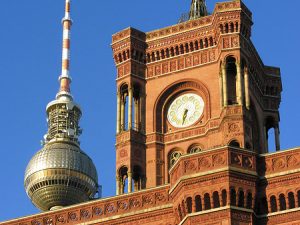BERLIN SCHOLAR Dr. BENEDIKT GOEBEL

Have a question about Berlin history?
Dr. Benedikt Goebel knows it backwards and forwards.
Unflinching about documenting the Nazi-era history of his city, this outstanding scholar worked on the bedrock scholarship on view at the STOLEN HEART exhibit in New York City.
This photo shows Benedikt with a bronze bell made in 1646 for the Lützower Dorfkirche, a Protestant church in Berlin.
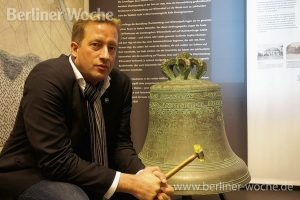
Benedikt Goebel was born in Münster, Germany, where, at the end of the Thirty Years’ War in 1648, a peace treaty was signed. Dutch painter Gerard ter Borch painted this representation of the treaty signing in Münster.
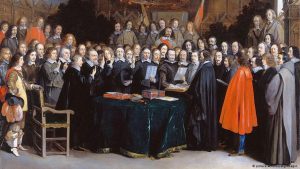
In addition to studying in Münster and Vienna, Dr. Goebel studied at the Humboldt University of Berlin. Here is a photo of the main entrance to the school.
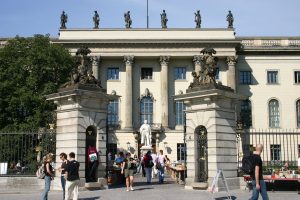
Currently, Dr. Goebel and his family live in Berlin’s Charlottenburg neighborhood. This next photo shows the Theater des Westens in Charlottenburg.

Benedikt tells me: “Charlottenburg is separated from Berlin’s Mitte district by Tiergarten — an ideal place for me to live. I like everything about my neighborhood; all of the old and new buildings and restaurants, the beautiful Kantstrasse, the side streets off the Kudamm — Charlottenburg is not as hip as Mitte and not as Yuppie-ish as Prenzlauer Berg. As a recent blog post put it, in Charlottenburg, one lives surrounded by history.”
I asked Dr. Goebel when he first became interested in history, and why.
“As a student, history was the topic for which I had the most natural enthusiasm. My paternal grandfather was a historian and my parents were very interested in history as well.”
When, and why, did Benedikt decide to center his career on the history of Berlin?
“In 1995, when I moved from Vienna to Berlin to finish an advanced degree, I already knew that I wanted to study the attempted reconfiguring of Berlin in the Nazi era. Why? The information pertaining to that, and related arcane topics would seem to be all around one here, nonetheless, and remarkably, there are a lot of very important relevant questions that we scholars have yet to answer.”
The STOLEN HEART exhibit in New York was originally a much larger German-language exhibit in Berlin, Geraubte Mitte. This next photo was taken within the Geraubte Mitte exhibit; Benedikt is at the center and I am to the right in a black dress.
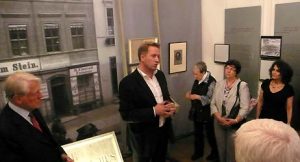
I asked Dr. Goebel about the origins of the Geraubte Mitte exhibit.
“For my doctoral thesis, I researched and documented the Aryanization of every single building in the Old City center of Berlin. Together with my fellow researcher Lutz Mauersberger of the Berlin-Mitte-Archiv, I later furthered the work I had done on that topic by expanding the scope of the research to include the entire Baroque-era city-center. Lutz and I, along with my wife Gesa Kessemeier conducted in-depth research of five families who had owned one or more buildings in this part of the city, your Intrator/Berglas family history included. Our findings were used for the Geraubte Mitte exhibit.”
What messages do you hope visitors take away from the STOLEN HEART exhibit?
“The exhibit of course makes plain that Berlin isn’t just an exciting contemporary city but that it has a complex and often tragic past. Imagine that 92% of the pre-war buildings in Berlin’s city center were destroyed either during the Second World War or in the immediate post-war period when this part of the city fell under communist control. The five families included in this exhibit all suffered at the hands of the Nazis; outrageous property theft and hair-raising persecution. Hopefully, exhibit visitors will come away deeply moved. ”
Earlier this year, you were quoted extensively in an article about houses of worship in Berlin that no longer exist because they were destroyed. Please describe what that was about.
“There was an exhibit called “St. Nowhere; Lost Houses of Worship in Berlin’s Mitte District.” It presented, for the first time, 26 lost houses of worship — 4 synagogues and 22 Evangelical churches — of center-city Berlin. Almost nothing remains of those structures. We are committed to getting some sort of markers for these former churches and synagogues made a part of contemporary city life, perhaps in the form of wooden or stone representations of the floor plans of the former houses of worship. We intend to publish a book on this subject by the end of 2016.”
On which projects are you currently working?
“In addition to the “St. Nowhere” book, I’m working on a number of additional writing projects. I also am engaged in the creation of a scale model of Berlin, made out of bronze, for the Marienkirchhof — a famous, very beautiful Berlin cemetery. Then too, I’m working on a special historical report for the European Court of Human Rights. And, I continue building up an online Databank for Center-City Berlin Research. In a Berlin high-school, I teach a course on architectural history and the maintenance of historical monuments. I’m hoping to see our STOLEN HEART exhibit travel beyond New York City. And I’m gearing up for an important symposium next year, the topic of which will be the future of Berlin’s Mitte district. I furthermore belong to twelve professional associations — and I love to spend time with my wife and our two daughters.”
I asked Benedikt to name some of his favorite things in Berlin. Here are three of them:
1) The Schleusenkrug Beer Garden

2) The Grosz Restaurant, Coffee House and Bar on the Kurfürstendamm
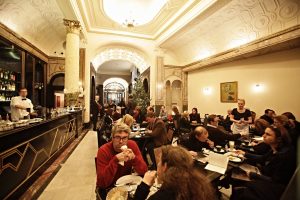
3) The tower atop City Hall — the Rotes Rathaus:
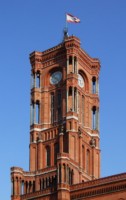
Dr. Benedikt Goebel’s center city Berlin research organization is here online.
For German-speakers with an interest in Mitte history, he maintains a group Facebook page here.
